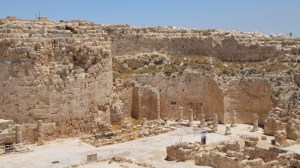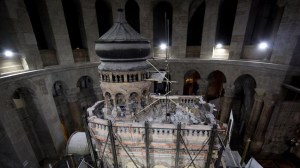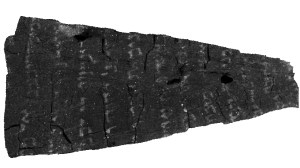In this series

Biblical Archaeology discoveries made in 2013 have given us new information about biblical events and people. This list is subjective, and based on news reports rather than peer-reviewed articles in scientific publications.
These discoveries illustrate the important work that goes on at excavations across Israel every year, and just scratch the surface of what has been found in 2013. Quite possibly a decade from now, with added perspective and more digging, the most important discoveries of 2013 may look different than this list.
1. The Egyptian Scarab of Khirbet el-Maqatir
This tiny 3/4-inch long amulet, carved in the familiar shape of a dung beetle, has been dated to the Late Bronze I period, 1550-1450 BC. Its discovery in the remains of a fortress at Khirbet el-Maqatir, nine miles north of Jerusalem, strengthens the case being made by the excavators that this site is the real location of Ai, the city destroyed in Joshua 8.
The site archaeologists have traditionally associated with Ai, nearby et-Tell, lacks destruction that could be dated to the time of Joshua, which raised questions about the accuracy of the conquest narrative.
2. Jezreel Winepress
Ancient winepresses are found all over Israel. The fact that this winepress is one of the largest, and is located near one of the most famous vineyards of the Bible, makes it of interest.
1 Kings 21 tells the story of how the evil Queen Jezebel plotted with her husband, King Ahab, to eliminate Naboth and convert his vineyard to a garden for the king's palace.
Jezreel was one of the capital cities of the northern kingdom, an important site in the history of Israel, but it has been lightly excavated. And despite 7,000 years of history at the site, based on the pottery that has been found, it is not a steep-sided tel (hill) like the nearby sites of Megiddo and Beit She'an.
The new excavation which began in 2013 has not yet determined the date of this winepress. But ultimately the excavation should reveal more of the history of this city, which Ahab and Jezebel favored over Samaria.
3. The Wine Cellar of Tel Kabri
Working double shifts, excavators pulled 40 wine jars from a storage room in the ruins of a palatial building eight miles northeast of Akko. The capacity of the jars, more than 500 gallons, would fill about 3,000 bottles of wine. It's Israel's oldest and largest wine cellar.
The ingredients detected in the wine residues discovered inside the jars are similar to the ingredients described in cuneiform tablets excavated in the 1930s in the ruins of Mari, a Sumerian and Amorite city on the Euphrates River.
This Canaanite palace—dated to about 1700 BC—was already known for the fragments of rare Minoan-style wall and floor frescoes discovered there in previous years. The identities of its sophisticated inhabitants haven't been determined.
4. Royal Public Buildings at Khirbet Qeiyafa
The palace of King David, as some reports described it, was probably not used as living quarters by King David. But the palatial ruins and nearby storehouse excavated in the seventh and final excavation season helped confirm Khirbet Qeiyafa's identification as a heavily fortified Judahite city from the time of King David.
Overlooking the Elah Valley, where David famously confronted Goliath, Khirbet Qeiyafa was clearly constructed to help protect Jerusalem and the Judean highlands from the lowland Philistines.
5. The Sphinx of Hazor
The front paws of a sphinx, found this past summer at Tel Hazor, have the name of Menkaure in an inscription written between them. Menkaure is a fourth-dynasty pharaoh who built the third and smallest of the great pyramids on the Giza plateau about 1,000 years before the Exodus.
No other sphinx statues have been found outside of Egypt in the eastern Mediterranean. This statue fragment was found in a destruction layer dated to the 13th century BC, the period of the Judges. Judges 4 tells the story of Deborah and the uprising against Jabin, Canaanite king of Hazor.
6. Gold Hoard Found Near the Temple Mount
A gold medallion, four inches in diameter with a menorah depicted on it, was found in the ruins of a Byzantine-era structure just 50 yards from the southern wall of the temple mount. Thirty-six gold coins were also found in the cache, along with gold and silver jewelry.
This spectacular find dates to the seventh century AD, later than the biblical period. But they may bring new understanding to this dynamic era which saw the Persians wrest control of Jerusalem from Roman Christians, raising the hopes of Jews who wanted to see the temple rebuilt. But then the Christians regained control of Jerusalem, only to lose it again to Muslim conquerors, and a mosque was built on the Temple Mount.
7. Roman Legion Base in Galilee
Archaeologists used high resolution satellite photography and ground penetrating radar to identify the location of the headquarters used by the Sixth Roman Legion between 120 and 300 AD. The site is between Tel Megiddo, one of the most important sites of Biblical Archaeology, and the previously discovered remains of one of the earliest known Christian houses of worship. Plans are being made to develop the area into a major tourism destination.
8. Mt. Zion Priestly Mansion
Archaeologists working just outside the walls of the Old City of Jerusalem, near the Zion Gate, are uncovering a mansion from the time of Christ. The unusually well-preserved lower levels of the home may reveal new information about first-century life. The finds so far include a bathroom. The home was probably occupied by a family of temple priests.
9. An Extra Destruction Level at Gezer
In the process of removing a tenth-century Iron Age wall to get to a Late Bronze Age destruction level dating to around 1400 BC, excavators at Gezer found a previously unknown destruction level between the two periods. Gezer is a benchmark site in Biblical Archaeology. This excavation and two additional projects going on at the site—a survey of the surrounding area and an excavation of the Gezer water system—should ultimately reveal new information about life before and after the time of the Israelite settlement.
10. Stone pyramid under the Sea of Galilee
This cone-shaped pile of rocks raised a lot of questions during 2013. How and why it's located underwater near the southern outlet of the lake is so far a mystery. Tentatively dated to around 2000 BC, or earlier, it may be connected to a nearby excavated site called Khirbet Kerak. Underwater archaelogists hope to begin studying the rocks to see if they can discover why they are there.
Gordon Govier is editor of ARTIFAX magazine and host of The Book & The Spade radio program.

















